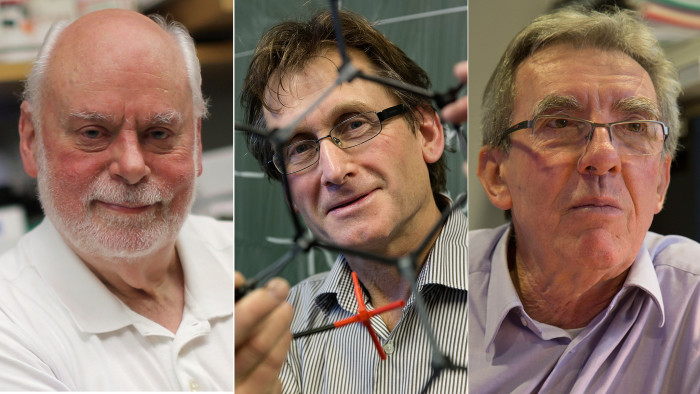Nano-machine inventors win Nobel chemistry prize

Simply sign up to the Global Economy myFT Digest -- delivered directly to your inbox.
The Nobel chemistry prize has been awarded to three scientists who designed and produced “the world’s smallest machines”.
Jean-Pierre Sauvage of France, Sir Fraser Stoddart of Britain and Bernard Feringa of the Netherlands shared the SKr8m ($928,000) prize for turning organic molecules into nano-machines with components 1,000 smaller than the width of a human hair. They include a tiny lift, artificial muscles, minuscule motors and recently nano-cars.
“The development of computing demonstrates how the miniaturisation of technology can lead to a revolution,” said the Royal Swedish Academy of Sciences which awards the prize. “The 2016 laureates in chemistry have miniaturised machines and taken chemistry to a new dimension.”
Prof Sauvage (71) of the University of Strasbourg took the first step towards a molecular machine in 1983, when he succeeded in linking ring-shaped molecules together to form a “catenane” chain.
In 1991 Prof Stoddart (74), then working at the University of Birmingham, took the second step when he made a “rotaxane”. He threaded a molecular ring on to a thin axle with stoppers at each end, and moved the ring along the axle like a nano-shuttle. Among his rotaxane developments are a molecular lift, muscle and computer chip.
Prof Feringa (65) of the University of Groningen was the first scientist to develop a proper molecular motor. In 1999 he got a molecular rotor blade to spin continually in the same direction. Using molecular motors, he has rotated a tiny glass cylinder that is 10,000 times bigger than the motor and also designed a nano-car driven by four molecular wheels.
Speaking by phone to the Nobel announcement news conference, Prof Feringa said: “I am a bit shocked. It’s a great surprise. I’m honoured and emotional about it.”
He added that he had a similar feeling when, looking through a microscope, he saw his first molecular motor in motion: “It was also a shock when I saw movement. I could hardly believe it worked.”
According to Royal Swedish Academy of Sciences, “the molecular motor is at the same stage as the electric motor was in the 1830s, when scientists displayed various spinning cranks and wheels, unaware that they would lead to electric trains, washing machines, fans and food processors. Molecular machines will most likely be used in the development of things such as new materials, sensors and energy storage systems.”
Prof Feringa said: “I feel a little bit like the Wright brothers who were flying 100 years ago for the first time and people were saying why do we need a flying machine? . . . The opportunities are great because if you think what kinds of materials we can make these days with the chemistry and when you are able to introduce dynamic function, there is endless opportunity.”
While Professors Sauvage and Feringa are still working at the universities where they made their groundbreaking discoveries in the 1980s and 1990s, Prof Stoddart moved from Birmingham to the University of California, Los Angeles, in 1997 and on to Chicago’s Northwestern University in 2008. He was knighted in 2006.
Prof Stoddart is the third expatriate Scot — and fourth expatriate Briton — working in the US to win a Nobel science prize this year. Scottish-born David Thouless and Michael Kosterlitz shared the physics prize on Tuesday with Duncan Haldane who grew up in London.
Comments